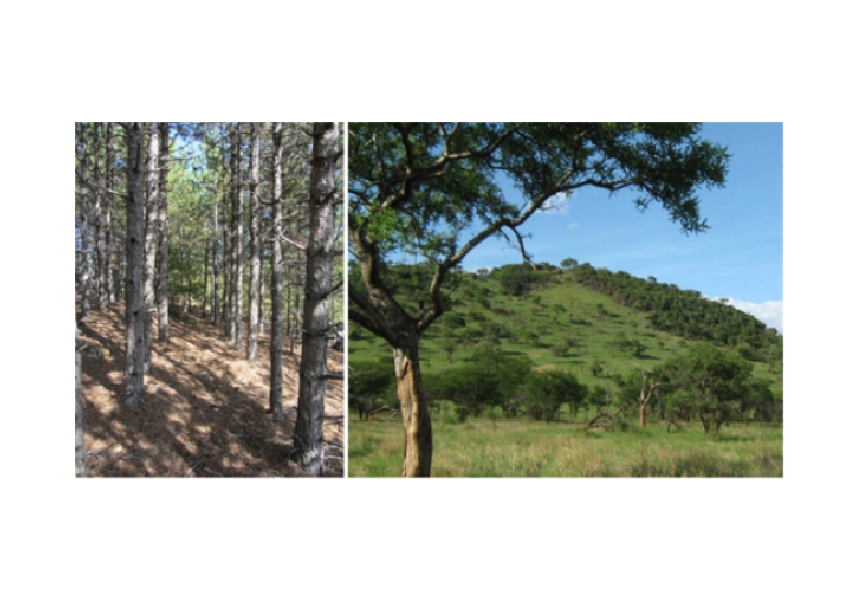
Carbon dioxide emitted into the atmosphere from the burning of fossil fuels is causing the Earth to warm, oceans to acidify, and climates to change. Because trees capture carbon through photosynthesis, some scientists and environmental advocacy groups are promoting massive tree planting as a solution to climate change.
A group of 46 scientists from around world, led by Joseph Veldman of Texas A&M University, are urging caution.
A group of 46 scientists from around world, led by Joseph Veldman of Texas A&M University, are urging caution. In a Technical Comment published in the journal Science, they demonstrate that recent research dramatically overstated the potential for tree planting to mitigate climate change, and that planting trees in the wrong places can destroy ecosystems, increase wildfire intensity, and exacerbate global warming.
Veldman said: “While tree planting can be good in some deforested areas, tree planting in Earth’s natural grasslands destroys plant and animal habitat and will not sequester enough carbon to compensate for fossil fuel emissions.”
The Technical Comment is a critique of another recent paper a recent paper in Science, led by Jean-Francois Bastin and Thomas Crowther of the Swiss Federal Institute of Technology in Zurich. These researchers, funded by a Dutch non-profit foundation (DOB Ecology), a tree planting advocacy group (Plant-for-the-Planet), and the German Federal Ministry for Economic Cooperation and Development, claimed that global tree planting could capture 205 gigatons of carbon, or one-third of the carbon dioxide emitted since the industrial revolution.
Veldman points out that: “Because the estimate of 205 gigatons of carbon was so large, in July of 2019, headlines around the world declared tree planting to be the best solution to climate change. We now know those headlines were wrong.”
In their critique, Veldman and his collaborators write that the Swiss research had serious flaws that led to a five-fold overestimate of the potential for new trees to mitigate climate change. Among the problems, the original study assumed that soils in ecosystems without trees contain no carbon, when in fact many ecosystems, such as savannas and peatlands, contain more carbon in soils than in the aboveground vegetation. The Swiss research also neglected the fact that coniferous forests in boreal and high mountain regions absorb more sunlight and emit more heat than treeless areas, and actually exacerbate rather than mitigate global warming. Finally, Veldman and his collaborators argue that tree planting in grasslands and savannas, as proposed by the Swiss researcher team, is damaging to the environment. Juli Pausas, CSIC researcher (Spain) and co-author of the article, adds that “a massive tree planting in grasslands and savannas, apart from the problems for biodiversity, would generate homogeneous and flammable landscapes that sooner or later would end up being feeding large fires. ”
Veldman says that “Ancient grasslands and savannas contain immense biodiversity and provide services to humanity, such as livestock forage and groundwater recharge. We worry that a myopic focus on tree planting will reduce the capacity of people to adapt to climate change while distracting from efforts to conserve intact ecosystems and reduce fossil fuel consumption.”
Co-author Vicky Temperton of Leuphana University in Germany, adds: “Ecological restoration could contribute so much more to natural climate solutions if we work to restore not just forests, but also grasslands, savannas, shrublands, and peat bogs.”
Veldman JW, Aleman JC, Alvarado ST, Anderson TM, Archibald S, Bond WJ, Boutton TW, Buchmann N, Buisson E, Canadell JG, Dechoum MdS, Diaz-Toribio MH, Durigan G, Ewel JJ, Fernandes GW, Fidelis A, Fleischman F, Good SP, Griffith DM, Hermann J-M, Hoffmann WA, Stradic SL, Lehmann CER, Mahy G, Nerlekar AN, Nippert JB, Noss RF, Osborne CP, Overbeck GE, Parr CL, Pausas JG, Pennington RT, Perring MP, Putz FE, Ratnam J, Sankaran M, Schmidt IB, Schmitt CB, Silveira FAO, Staver AC, Stevens N, Still C, Strömberg CAE, Temperton VM, Varner JM, Zaloumis NP. On The global tree restoration potential. Science. DOI: 10.1126/science.aay7976
Photography:
Left: tree planting poor in biodiversity in southern Bulgaria; An important part of the plantation was affected by a high intensity fire 50 years after planting. Right: mosaic of forests and savannas with high biodiversity and frequent low intensity natural fires.
More information:
http://jgpausas.blogs.uv.es/2019/10/17/afforestation-is-not-a-solution-to-mitigate-co2-emissions/
CIDE Comunication










